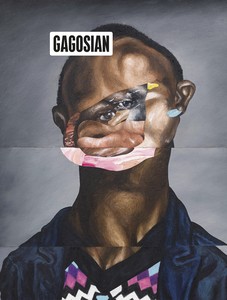
Now available
Gagosian Quarterly Fall 2019
The Fall 2019 issue of Gagosian Quarterly is now available, featuring a detail from Sinking (2019) by Nathaniel Mary Quinn on its cover.
May 15, 2017
A whole generation of artists and art has been largely deprived of the intensely complex but wildly influential work of the Japanese-born artist Arakawa, who forged prescient and crucial links between Dadaism, abstract art, Minimalism, conceptual art, Pop art, and more. As a result, Arakawa’s work has an almost revelatory quality now, refreshingly apparent in Gagosian West 24th Street’s show of six seldom-seen paintings from the 1960s and 1970s. Text by David Colman.
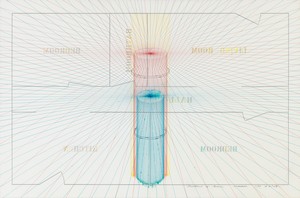
Arakawa, Texture of Time, 1977, acrylic, pencil, art marker on canvas, 69 × 103 ½ inches, framed (175.3 × 262.9 cm)
Arakawa, Texture of Time, 1977, acrylic, pencil, art marker on canvas, 69 × 103 ½ inches, framed (175.3 × 262.9 cm)
Today’s golden age of rediscovery has truly embraced the spirit of the hunt, poring into art history books and poking into attics to resurrect and restore critical attention and acclaim to many unjustly neglected artists’ oeuvres and legacies. So it’s natural that one could assume a similar story line behind the career of the expansive and cerebral Japanese-American painter Arakawa.
But, as befits his always-surprising career, the story of Arakawa is no simple rediscovery of a neglected talent. In the first place, painting didn’t leave him—he left painting. Around 1990, Arakawa decided to shift his focus away from his art-making practice to work with his wife and longtime collaborator Madeline Gins on theoretical architecture projects. In the second place, this second act was like a second show all its own, producing ambitious, colorful, and mind-bending buildings like the Bioscleave House (aka Life Expanding Villa) they completed in East Hampton, NY, a decade ago (with a sculptural “floor” as uneven as an Alpine hike). Designed to rejuvenate the sensory system and reverse the aging process, this and other housing projects broke through many boundaries: not just of art, but architecture, philosophy, phenomenology, biology, domesticity, cognitive theory, and probably a dozen other realms still to be named.
But to view the works in Arakawa: Six Paintings is to reconsider his overlooked legacy from its 1960s beginnings rather than its culmination. This is not an artist who forsook art for architecture, but an artist who reveled in accommodating, exploring, and reconciling the half-dozen or more art movements that were variously vying for supremacy in the ’60s and ’70s (and yet never epitomizing a single one). While only comprising six works, the show makes clear what an incredible hub of aesthetic and philosophical ideas Arakawa managed to represent in his painting, from the superficial visual elements to the abstruse theoretical concepts. From the Neo-Dada school, there are Rauschenberg-ian images and a sketchy, Twombly-esque aesthetic of ephemerality. There are the stenciled numbers and letters—present in Jasper Johns’s work as well as in proto-Pop artists like Larry Rivers and Robert Indiana. His work also dovetails neatly with the text-driven practices of conceptual artists like Joseph Kosuth and Lawrence Weiner (not to mention his fellow Japanese conceptualist Yoko Ono). And from Marcel Duchamp—an early champion soon after Arakawa arrived in New York from his native Japan in 1961—the painter absorbed provocative relational ideas about the essential nature of art as something experienced by a viewer.
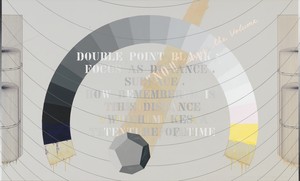
Arakawa, "NO!!" Says the Volume, 1978, acrylic, pencil, art marker on canvas, 75 × 123 inches (190.5 × 312.4 cm)
Indeed, what’s so engrossing about the brief show is how deftly Arakawa manages so masterfully to weave together seemingly diverse movements into something that reads nonetheless as wholly authentic and unique. One 1971 canvas, From Mechanism of Meaning, merges freehand scribbling with a rigid conceptual framework to create an engagingly messy chart of more than two dozen ways to conceive of (or perceive) a lemon. (Some of the options: PAINTING OF A LEMON, LAST LEMON, MEMORY OF A LEMON, ACTUAL LEMON, HIDDEN LEMON, et al.) Other works merge, say, the conceptually scientific with the fancifully absurdist just as naturally, as if Arakawa was born to hybridize.
At the same time, the irony is that Arakawa is so formidably unique—arguably more unique than some artists to which he’s linked. But as visionary as he was, his layered aesthetic highlights a signal failure in today’s machinery of art appreciation: that is, its marked tendency to value artists that epitomize one singular practice or aesthetic over artists who function as hubs and connectors between movements and worlds.
That has been changing in the last decade, with the new engine of rediscovery having redirected critical focus to unorthodox artists the canon march left behind. That is the story here. Arakawa accommodated art, art didn’t accommodate him. From the look of this show, this time around it can and will. For a man who dreamt that art and architecture could somehow point the way to (if not deliver) eternal life, this overdue renaissance is a special kind of justice in more ways than one.
Artwork © 2017 Estate of Madeline Gins. Reproduced with permission of the Estate of Madeline Gins. Photos by Rob McKeever. Arakawa: Six Paintings at Gagosian West 24th Street, New York, May 2–26, 2017.

The Fall 2019 issue of Gagosian Quarterly is now available, featuring a detail from Sinking (2019) by Nathaniel Mary Quinn on its cover.
The exhibition Arakawa: Diagrams for the Imagination receives a closer look by Gagosian director Ealan Wingate. In this video, he discusses the artist’s arrival in New York and examines the importance of maps and language in Arakawa’s work.

Mary Ann Caws reflects on the centrality of perception and imagination in Arakawa’s art, from his early diagrammatic paintings to his later architectural investigations with Madeline Gins.
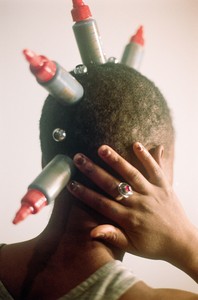
Ryuan Johnson, sculptor and creative director, focuses on the works of Allana Clarke and Lauren Halsey to examine the key place of hair in Black culture. Through image and poetry, Johnson reveals the cultural and historical significance of hair as a medium to discuss identity, community, and the politics of representation.
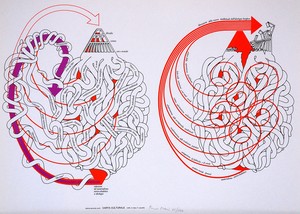
The exhibition Enzo Mari, curated by Hans Ulrich Obrist with Francesca Giacomelli at the Design Museum, London, runs through September 8. Taking a cue from this major retrospective, Bartolomeo Sala delves into Mari’s practice and convictions.

Sydney Stutterheim has published Artist, Audience, Accomplice: Ethics and Authorship in Art of the 1970s and 1980s (Duke University Press, 2024), a survey of performance art and related practices that involve, in various manners, the figure of the accomplice. To celebrate the publication, the Quarterly is publishing an excerpt that examines Chris Burden’s Deadman (1972).
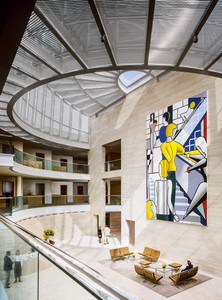
Michael Ovitz, cofounder of Creative Artists Agency (CAA), looks back to 1989, the year he and the architect I. M. Pei commissioned Roy Lichtenstein to create the Bauhaus Stairway Mural for the then new CAA Building in Los Angeles. Through the experience of working with Lichtenstein, Ovitz formed a meaningful friendship with the artist.

David Cronenberg’s film The Shrouds made its debut at the 77th edition of the Cannes Film Festival in France. Film writer Miriam Bale reports on the motifs and questions that make up this latest addition to the auteur’s singular body of work.
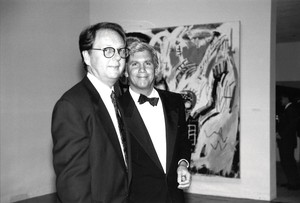
Alison McDonald celebrates the life of curator Richard Marshall.

Alice Godwin and Alison McDonald explore the history of Roy Lichtenstein’s mural of 1989, contextualizing the work among the artist’s other mural projects and reaching back to its inspiration: the Bauhaus Stairway painting of 1932 by the German artist Oskar Schlemmer.

The mind behind some of the most legendary pop stars of the 1980s and ’90s, including Grace Jones, Pet Shop Boys, Frankie Goes to Hollywood, Yes, and the Buggles, produced one of the music industry’s most unexpected and enjoyable recent memoirs: Trevor Horn: Adventures in Modern Recording. From ABC to ZTT. Young Kim reports on the elements that make the book, and Horn’s life, such a treasure to engage with.

Louise Gray on the life and work of Éliane Radigue, pioneering electronic musician, composer, and initiator of the monumental OCCAM series.